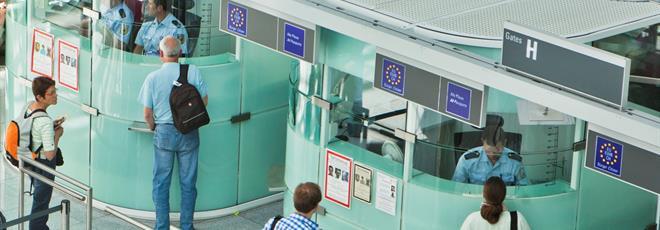In the ever-evolving tapestry of international travel, a new chapter is unfolding across the vibrant landscapes of Europe. With the introduction of the European Entry/Exit System (EES), the continent is on the brink of a significant transformation in how its borders are managed and traversed. This digital leap, designed to streamline the border crossing process and bolster security, is nurturing curiosity and queries from the swath of global travelers eager to explore Europe’s rich heritage and modern marvels.
Among those navigating this change are dual nationals, individuals who, by fortune or fate, hold citizenship in more than one country. These global citizens, often straddling cultures, traditions, and now, travel regimes, find themselves at a unique crossroads. The EES passport checks, a cornerstone of the new system, promise a blend of efficiency and scrutiny, aiming to redefine the rhythm of arrivals and departures.
As we embark on this exploration of what Europe’s EES passport checks will mean for dual nationals, we delve into a narrative that intertwines technology, policy, and personal identity against the backdrop of the European Union’s evolving borders. Amidst the chatter of travel forums and the detailed bulletins of immigration policies, this article aims to shed light on the nuances of the EES and its impact on those who, by virtue of their dual nationality, navigate a world without straightforward borders. Join us on this journey to understand how the paths of international travel and dual national identities intertwine and adapt in the face of Europe’s digital frontier.
Understanding the Basics of Europe’s EES Passport Checks
Navigating the intricacies of the forthcoming Entry/Exit System (EES) passport checks in Europe can feel like threading through a maze with dual nationality. With EES slated to revolutionize border control for non-EU nationals by digitizing and streamlining the entry and exit process, dual nationals might wonder where they stand in this new landscape. For starters, dual nationals should be prepared for a system that aims to enhance security while expediting legitimate travel. This means having both passports at the ready, as the EES will register entries and exits with a swipe, storing data such as name, travel document details, and biometrics. Understanding which passport to present could be crucial; typically, the passport of the country of citizenship if it’s an EU member state, or otherwise, the non-EU passport for the EES process.
In practical terms, let’s delve into the mechanics for a dual national entering the Schengen Area. Imagine you hold both Canadian and Italian citizenship. Upon approaching border control, presenting your Italian passport would affiliate you with your EU citizenship, potentially bypassing the EES check-in favor of the EU citizens’ lane. Conversely, arriving with a Canadian passport initiates the EES procedure: a digital photograph and four fingerprints collected, aimed at securing borders while smoothing your journey through them. This dual approach underscores the importance of knowing the most efficient and compliant way to navigate these checks.
| Quick Guide for Dual Nationals on EES Passport Checks | |
|---|---|
| EU Passport Holder | Use your EU passport to avoid EES checks and expedite your entry. |
| Non-EU Passport Holder | Be ready for EES checks, including biometric data collection. |
| Traveling to Schengen Area | Pick the passport of your destination or residency for a smoother process. |
Remember, the EES doesn’t just affect how quickly you can clear through customs; it also has implications for your privacy and the handling of your personal data. With biometric info being a significant component of what’s collected, dual nationals will have to weigh the convenience of swift passage with the realities of data security and privacy in an increasingly digital age. Balancing security with the freedoms of travel is at the heart of the EES, making it essential for travelers, especially those juggling identities across borders, to stay informed and prepared.
Navigating EES with Dual Nationality: Strategies and Insights
The Entry/Exit System (EES) set to revolutionize border control in the European Union brings with it a mixed bag of challenges and opportunities, especially for dual nationals who frequently traverse these borders. For travelers with allegiances to more than one country, the key to smooth transitions lies in understanding how EES interacts with multiple citizenships. First and foremost, it’s paramount to ascertain which passport to present when entering or leaving the Schengen Area. Generally, the rule of thumb is to use the passport of the country of your citizenship that is part of the EU when entering or exiting its borders. This strategy not only simplifies the border control process but also minimizes the risk of potential delays or complications.
In addition to choosing the right passport, there are several strategies dual nationals can employ to navigate the EES with ease:
- Consistency is King: Always use the same passport for entering and exiting the Schengen Area to ensure your entry and exit records match, reducing the likelihood of triggering security concerns.
- Stay Informed: Keep abreast of any changes or updates to the EES regulations that might affect dual nationals. This includes familiarizing yourself with the specific requirements your non-EU passport might face when traveling.
Furthermore, understanding the EES functionality that records dates of entry and exit can be a valuable tool for dual nationals in managing their stays within the EU and adhering to visa restrictions or duration of stay limits more efficiently. Staying ahead with precise record-keeping and strategic planning can turn the EES from a potential obstacle into a streamlined part of your travel routine.
| Nation | Strategy | Benefits |
|---|---|---|
| EU Member | Use EU passport | Smooth processing & fewer delays |
| Non-EU Member | Be aware of entry restrictions | Preparedness & compliance |
Embracing these strategies, dual nationals can ensure they’re well-prepared to navigate the European Union’s changing landscape of border control with confidence and ease.
Adapting to the New Norm: Practical Recommendations for Dual Nationals
The landscape of international travel within Europe is undergoing a significant shift, especially for dual nationals, with the imminent deployment of the Entry/Exit System (EES). Navigating this new digital border control mechanism requires understanding and adaptation. As dual nationals, the strategic choice of which passport to use when entering and exiting the Schengen Zone becomes more critical than ever. Always use the same passport for entering and exiting to maintain coherence in the EES database and avoid potential hiccups. Furthermore, maintaining updated information in both passports, ensuring they are valid for at least six months before travel, becomes not just a recommendation but a necessity.
For dual nationals, it’s not just about choosing the right passport; it’s also about staying informed and prepared. Here are some practical recommendations to ensure a smooth journey under the new EES regulations:
- Register any visa or residency information linked to one of your nationalities, as discrepancies could raise questions under the new system.
- Stay updated with the latest travel advisories and requirements from both your countries of citizenship and the European Union, as regulations can change rapidly.
- Consider enrolling in expedited travel programs offered by many countries for frequent travelers, which might help in reducing wait times and providing smoother entry and exit processes.
| Passport A (Country X) | Passport B (Country Y) |
|---|---|
| With Schengen Visa or EU residency | Without Schengen Visa or EU residency |
| Preferred for entering/exiting the Schengen Zone | Use for destinations outside Schengen to avoid complications |
Adapting to the EES requirements might seem daunting at first, but with a proactive approach and thorough preparation, dual nationals can continue to enjoy the benefits of their unique status while complying with new travel norms. Keeping abreast of these changes and planning your travel with them in mind is the key to a hassle-free European experience.
In Summary
As the sun sets over the rolling hills of Europe, a new dawn in travel documentation beckons with the introduction of the Entry/Exit System (EES). For dual nationals, this epoch brings with it a blend of curiosity and caution. It’s a journey that is as much about navigating the landscapes of identity as it is about crossing physical borders. In the tapestry of Europe’s future, the threads of technology, security, and personal identity are intertwining more closely than ever before.
As we’ve traversed the implications of the EES for those with dual nationality, it’s clear that while the path may be fraught with complexities, it’s also paved with the potential for greater clarity and streamlined processes. The dialogue between tradition and innovation, between national borders and global citizenship, continues to evolve, painting a dynamic panorama of Europe’s commitment to both security and openness.
In the end, the narrative of dual nationals in the era of the EES is an unfolding story, a journey rather than a destination. It’s an invitation to engage, to question, and to adapt. As we bid farewell to this chapter, let’s embrace the unfolding journey with an open heart and a keen mind, ready to navigate the changing landscapes of our interconnected world. Europe, with its rich tapestry of cultures and identities, stands at the cusp of a new chapter, one that promises to reshape the contours of travel and identity in the digital age.



